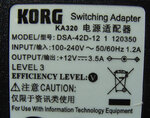RichO
Newbie level 5
Kind of an emergency situation here. I am with a band and the power supply to the electric keyboard died last night. They have a gig tonight and nobody sells replacement power supplies locally.
I am wondering if we can find another 12VDC 3.5A source (assuming unswitched) if that will work with the keyboard or if there is risk of damaging the keyboard. Here are the specs on the power supply.

Thanks
I am wondering if we can find another 12VDC 3.5A source (assuming unswitched) if that will work with the keyboard or if there is risk of damaging the keyboard. Here are the specs on the power supply.

Thanks